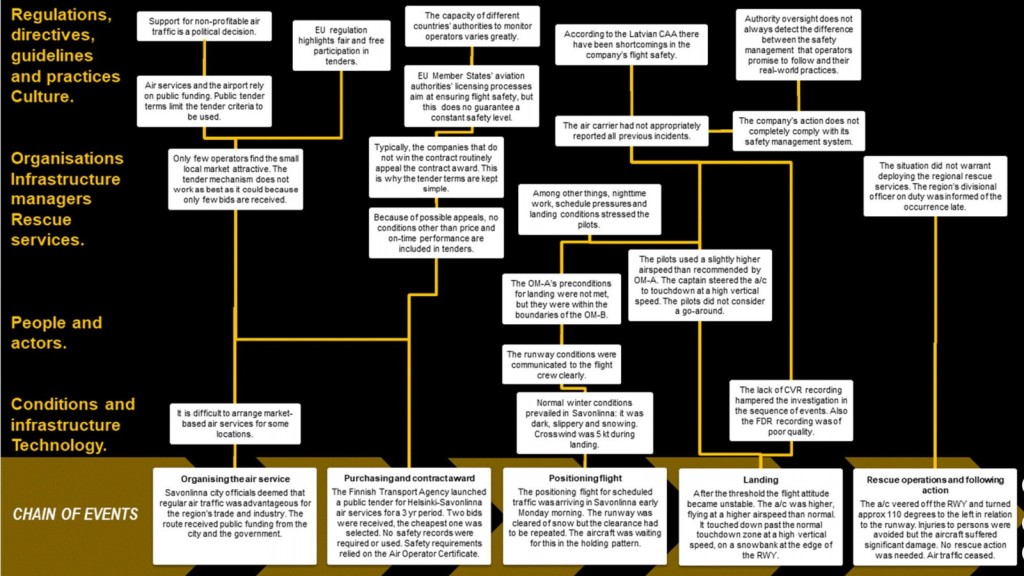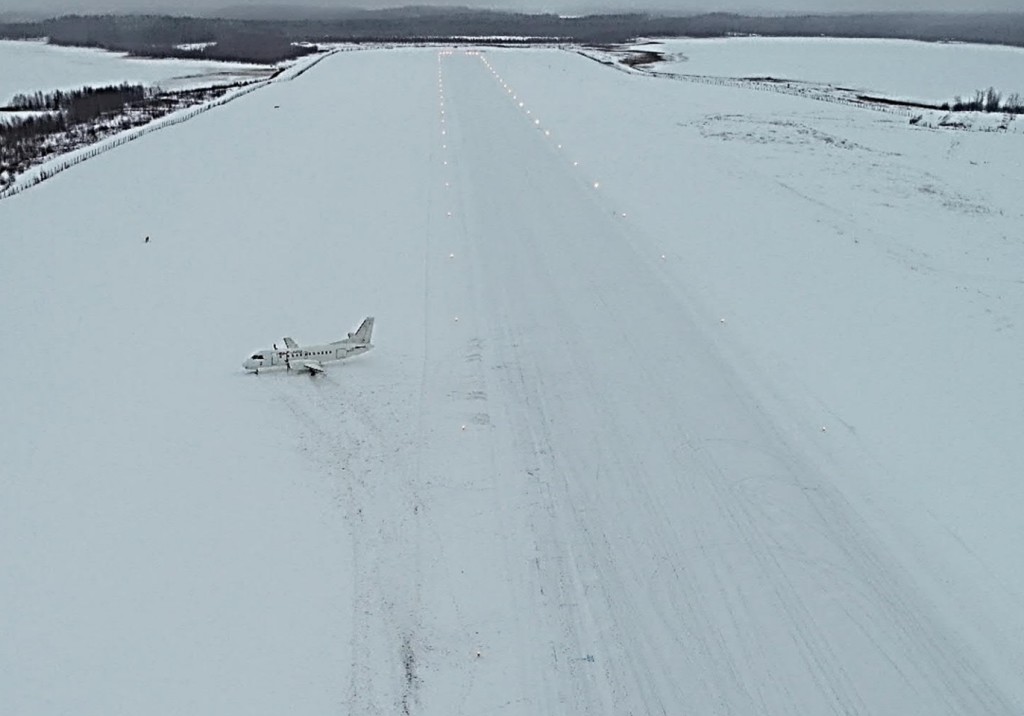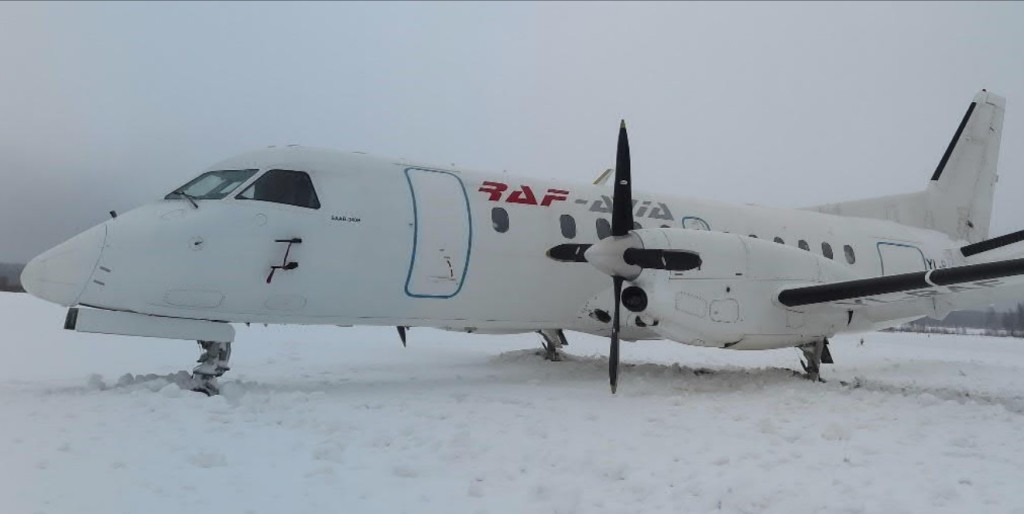Runway Excursion Exposes Safety Management Issues
On 7 January 2019 RAF-AVIA Saab 340B YL-RAF, positioning from the airline’s base at Riga in Latvia veered off the runway during the landing roll at Savonlinna Airport in Finland.
The Accident Flight
The Finnish Safety Investigation Authority (SIAF, the Onnettomuustutkintakeskus) explain in their safety investigation report that:
The runway had been cleared of snow but the clearance had to be repeated to achieve better runway friction. The aircraft had to wait for the landing in the holding pattern, and the landing was delayed. At the time of the landing it was dark, a crosswind was blowing, it was snowing and the runway was slippery.
The approach proceeded normally until the aircraft passed the threshold. At the final phase of the landing the aircraft floated close to the surface for 6–7 seconds before touchdown, following which the touchdown point moved farther down the runway than normally. Extra airspeed after the threshold partly contributed to this. The captain steered the aircraft toward the ground at a fairly high vertical speed. At that time the aircraft was already over the snowbank at the edge of the cleared area of the runway. Despite the pilot’s corrective control actions the aircraft veered off the runway into the snowbank. The flight crew comprised of two pilots and a ground engineer. Nobody was injured but the aircraft suffered significant damage.
They comment that:
At no time did the pilots consider aborting the approach or landing, i.e. going around. The airline’s operational manuals (OM-A and OM-B) were inconsistent concerning maximum crosswind components. According to the Operations Manual (OM-A) the crosswind limits given by the Aircraft Operations Manual (OM-B) must be followed during landing. However, the OM-A also says that if the estimated runway friction is poor, crosswind landings are prohibited. In other words, then the crosswind component should be zero knots. In this occurrence the AFIS officer informed the pilots that the runway friction was poor. The instructions were difficult to follow in practice.
The investigation was hampered because:
The Cockpit Voice Recorder had not recorded anything from the flight in question, and the earlier recordings that were retrieved from its memory were of extremely poor quality. The recording quality of the FDR, when compared to modern recorders, was poor. The magnetic tape of the FDR was worn, which caused defects in the recording.
The SIAF describe a phenomena where:
When snow is blowing sideways, a pilot may see an illusion when approaching the runway where the aircraft’s track is deviating from the intended track or the runway bearing. The illusion is stronger at nighttime when the aircraft’s landing lights are on.
The Contractual Arrangement, Due Diligence, Safety Management and Regulation
The airline had a contract from Finnish ground handling and logistics company Maavoima who had won the tender for the subsidised Helsinki–Savonlinna public service obligation route in April 2017. The contract was awarded by the Finnish Transport Agency to the lowest bidder. The FTA had stipulated no safety requirements beyond the requirements that the air operator hold a regulatory approval for fear that safety requirements would be seen as ‘anti-competitive’. SIAF highlight that the lack of additional safety requirements was the FTA’s choice. Furthermore, as prime contractor…
…Maavoima relied on the fact that air operator certificates and operating licences ensure that the air operator acts in a safe manner.
We would observe that almost every commercial air transport accident involves an approved air operator and regulations by definition set out the minimum standard!
No separate queries on their safety levels or their domestic flight safety records were done from the EASA’s or ICAO’s databases. Once the flight operations commenced, Maavoima supervised the on-time performance of flight schedules. Maavoima, in their safety management system, did not have any procedures or the obligation for assessing the airlines’ operating safety.
The investigators observed that:
The Latvian CAA audit reports of 3 August 2018 and 18 October 2018 state that the airline’s “reporting culture is not sufficient, so as to be effective”. On the basis of contacts with the Latvian CAA the airline’s inadequate reporting culture originates from the time when Latvia was part of the Soviet Union. In the society which preceded Latvia’s independence pilots would often avoid occurrence reporting because they could have been punished for doing so. Even though punishment is no longer a part of the airline’s procedures, it has been challenging to mitigate the fears of especially the older pilots.
In practice, the airline did collate a high rate of what the SIAF call ‘internal safety deviation reports’ each month (20-25 per month, flying c275 hours per month). This would normally be considered a very healthy reporting rate. Furthermore the procedures for safety reporting were described as ” comprehensive, detailed and extensive”. However:
The airline does not make a lessons-learned compilation for the company’s personnel regarding internally reported deviations. Correspondingly, the company only rarely reports deviations to the Latvian CAA.
The Finnish Transport and Communications Agency (Traficom) is the aviation authority in Finland (until 1 January 2019 they were the Finnish Transport Safety Agency). They ramp checked the service but found only an issue with the listing of portable fire extinguishers in the minimum equipment list and a missing screw on an engine cowling.
According to the Latvian CAA the airline’s most serious safety shortcomings at RAF-AVIA] are associated with pilot skills and decision-making. …the greatest challenge to supervising RAF-AVIA’s safety has been in modernising old-fashioned safety thinking. The Latvian CAA says that, through oversight, it has succeeded in improving RAF-AVIA’s previously immature safety management system. Recently, the problem has been that the air carrier has not been able to fully implement its safety management system. While, according to the Latvian CAA, the airline’s safety is improving, the change process has been slow.
SIAF warn that:
Airlines may paint a more positive picture of their action to oversight authorities by presenting impressive safety management system documentation…
SIAF Analysis
SIAF developed an AcciMap that summarises their analysis: 
SIAF Conclusions
The investigators concluded that:
The accident demonstrates the fact that the operating licences and air operator licences issued by the EU Member States’ aviation authorities do not guarantee constant and uniform safety levels among air carriers. While the EU’s regulations have aimed at ensuring the most open participation in tendering, they may result in overlooking the safety of aviation as one criterion in tendering. The purchaser organising the public tender for air services will not necessarily impose any safety-associated criteria because of being cautious about breaking EU competition rules and the court processes launched by losing bidders. Often the price and on-time performance are the tender criteria. Purchasers of air services do not have suitable and straightforward indicators to assess air carrier safety. Clients and purchasers may also include those that are not deeply familiar with the aviation branch.
Safety Recommendations
- The Finnish Transport and Communications Agency explore and instruct how operators’ aviation safety and safety management performance, as criteria, can be used in tendering for air services, taking the EU’s regulations into account.
- The European Commission see to it that a process is created by which it becomes possible to impartially assess operators’ safety management performance and safety levels in tendering for air services.
- The European Union Aviation Safety Agency (EASA) ensure that the audits conducted by the EU Member States on operators also cover the practical functioning and performance of safety management systems.
- The EASA set a deadline for the use of flight data recorders recording on magnetic tape.
Safety Resources
- Catastrophe in the Congo – The Company That Lost its Board of Directors
- Survey Aircraft Fatal Accident: Fatigue, Fuel Mismanagement and Prior Concerns
- British Midland Boeing 737-400 G-OBME Fatal Accident, Kegworth 8 January 1989
- Wrong Engine Shutdown Crash: But You Won’t Guess Which!: BUA BAC One-Eleven G-ASJJ 14 January 1969
- AAIB: Human Factors and the Identification of Saab 2000 Flight Control Malfunctions
- Procedural Drift at Saab 340 Operator Leads to Taxiway Excursion
- G200 Leaves Runway in Abuja Due to “Improper” Handling
- CRJ900 Skids Sideways Down Finnish Runway
- Improvised Troubleshooting After Cascading A330 Avionics Problems
- Challenge Assumptions: ATSB on A330 with a u/s GPS
- Gulfstream G-IV Take Off Accident & Human Factors
- Confusion of Compelling, But Erroneous, PC-12 Synthetic Vision Display
- ATR 72 In-Flight Pitch Disconnect and Structural Failure
- C-130J Control Restriction Accident, Jalalabad
- B777 in Autoland Mode Left Runway When Another Aircraft Interfered With the Localiser Signal
- Distracted B1900C Wheels Up Landing in the Bahamas
- B737 Speed Decay, Automation and Distraction
- Easyjet A320 Flap / Landing Gear Mis-selections
- Premature A319 Evacuation With Engines Running
- UPDATE 5 March 2020: S2000 Runway Excursion at the Start of the Take Off Roll
- UPDATE 8 June 2020: Fatal Falcon 50 Accident: Unairworthy with Unqualified Crew
- UPDATE 4 October 2020: Investigators Suggest Cultural Indifference to Checklist Use a Factor in TAROM ATR42 Runway Excursion
And in particular:
Also see our review of The Field Guide to Understanding Human Error by Sidney Dekker presented to the Royal Aeronautical Society (RAeS): The Field Guide to Understanding Human Error – A Review




Recent Comments